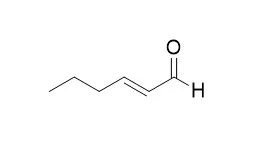| In vitro: |
| Journal of Chemical Ecology, 2005, 31(3):481–495. | | Further Field Evaluation Of Synthetic Herbivore-Induced Plan Volatiles As Attractants For Beneficial Insects.[Reference: WebLink] |
METHODS AND RESULTS:
Fifteen synthetic herbivore-induced plant volatiles (HIPVs) were field-tested for attractivity to beneficial insects in two experiments conducted in an open field and a hop yard in Washington State. Eleven insect species or families showed significant attraction to 13 HIPVs. The ladybeetle, Stethorus punctum picipes, was attracted to sticky traps baited with methyl salicylate (MeSA), cis-3-hexen-1-ol (He), and benzaldehyde (Be). The minute pirate bug, Orius tristicolor, was attracted to traps baited with MeSA, He, Be, and octyl aldehyde (Oa), and the bigeyed bug, Geocoris pallens, responded to MeSA, indole, and trans-2-Hexen-1-al. The mymarid wasp, Anagrus daanei, was attracted to He, Oa, and farnesene. The chloropid fly, Thaumatomyia glabra, was highly attracted to methyl anthranilate. Insect families responding to HIPVs included Syrphidae (MeSA, He), Braconidae ((Z)-3-hexenyl acetate, He, cis-jasmone (J), methyl jasmonate (MeJA), methyl anthranilate (MeA)), Empididae (MeSA), Sarcophagidae (MeSA, Be, J, nonanal and geraniol), Tachinidae (Be), and Agromyzidae (MeSA). Micro-Hymenoptera (primarily parasitic wasp families) were attracted to MeSA, He, and indole.
CONCLUSIONS:
These results are discussed with respect to known properties and bioactivity of the tested HIPVs and to their potential as tools for recruiting natural enemies into agroecosystems. | | Journal of Economic Entomology, 01 Dec 2014, 107(6):2023-2029. | | Slow Release of Plant Volatiles Using Sol-Gel Dispensers.[Reference: WebLink] | The black citrus aphid, also known as the tea aphid, (Toxoptera aurantii Boyer) attacks economically important crops, including tea (Camellia sinensis (L.) O. Kuntze).
METHODS AND RESULTS:
In the current study, silica sol-gel formulations were screened to find one that could carry and release C. sinensis plant volatiles to lure black citrus aphids in a greenhouse. The common plant volatile trans-2-Hexen-1-al was used as a model molecule to screen for suitable sol-gel formulations. A zNose (Electronic Sensor Technology, Newbury Park, CA) transportable gas chromatograph was used to continuously monitor the volatile emissions. A sol-gel formulation containing tetramethyl orthosilicate and methyltrimethoxysilane in an 8:2 (vol:vol) ratio was selected to develop a slow-release dispenser. The half-life of trans-2-Hexen-1-al in the sol-gel dispenser increased slightly with the volume of this compound in the dispenser.
CONCLUSIONS:
Ten different volatiles were tested in the sol-gel dispenser. Alcohols of 6-10 carbons had the longest half-lives (3.01-3.77 d), while esters of 6-12 carbons had the shortest (1.53-2.28 d). Release of these volatiles from the dispensers could not be detected by the zNose after 16 d (cis-3-hexenyl acetate) to 26 d (3,7-dimethylocta-1,6-dien-3-ol). In greenhouse experiments, trans-2-Hexen-1-al and cis-3-hexen-1-ol released from the sol-gel dispensers attracted aphids for ≍17 d, and release of these volatiles could not be detected by the zNose after ≍24 d. The sol-gel dispensers performed adequately for the slow release of plant volatiles to trap aphids in the greenhouse. | | Current Biotechnology, 2017, 6(3):245-251. | | Saccharomyces cerevisiae as a Model for Screening the Effects of Volatile Organic Compounds[Reference: WebLink] | Volatile organic compounds (VOCs) are gaseous at room temperature, readily dissipate throughout the environment, and may be of anthropogenic or biogenic origin. Despite an increasing scientific interest in the role VOCs play in interspecific interactions, there remains a limited understanding of the impact of VOCs on fungi living in a shared space. In this study, we aimed to determine the sensitivity of the model organism Saccharomyces cerevisiae (yeast) in response to exposure to VOCs, collectively or singularly produced by bacteria, fungi, plants, and in industrial processes, and containing various chemical functional groups.
METHODS AND RESULTS:
Using a serial dilution spot assay with yeast wild-type strain BY4741, 27 compounds were screened at 10 ppm for 48 hr to determine their impact on yeast growth. We found that gas-phase formaldehyde, three common microbial VOCs, 1-octanol, 1-octen-3-one, and trans-2-octenal, and a common plant VOC, trans-2-Hexen-1-al, completely inhibited yeast growth at 10 ppm, while 1-octen-3-ol, 2-methylpropanal and benzene were significantly limiting. Additionally, we identified 2 common microbial VOCs, 3-methyl-1-butanol and 3-octanone, that significantly increased yeast growth.
CONCLUSIONS:
This study demonstrates that yeast provides a useful tool to study the effects of VOCs in shared spaces, serving as a model for other eukaryotic species in the built environment. |
|






 Cell. 2018 Jan 11;172(1-2):249-261.e12. doi: 10.1016/j.cell.2017.12.019.IF=36.216(2019)
Cell. 2018 Jan 11;172(1-2):249-261.e12. doi: 10.1016/j.cell.2017.12.019.IF=36.216(2019) Cell Metab. 2020 Mar 3;31(3):534-548.e5. doi: 10.1016/j.cmet.2020.01.002.IF=22.415(2019)
Cell Metab. 2020 Mar 3;31(3):534-548.e5. doi: 10.1016/j.cmet.2020.01.002.IF=22.415(2019) Mol Cell. 2017 Nov 16;68(4):673-685.e6. doi: 10.1016/j.molcel.2017.10.022.IF=14.548(2019)
Mol Cell. 2017 Nov 16;68(4):673-685.e6. doi: 10.1016/j.molcel.2017.10.022.IF=14.548(2019)